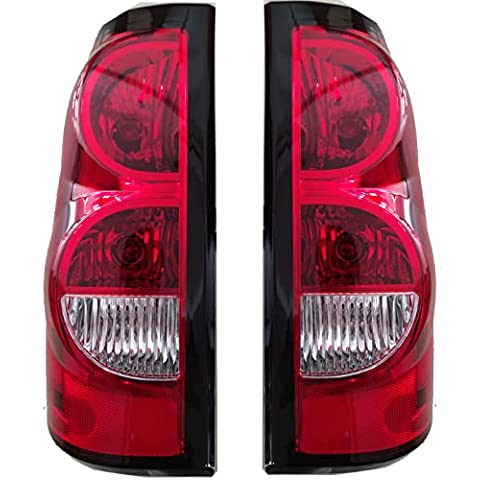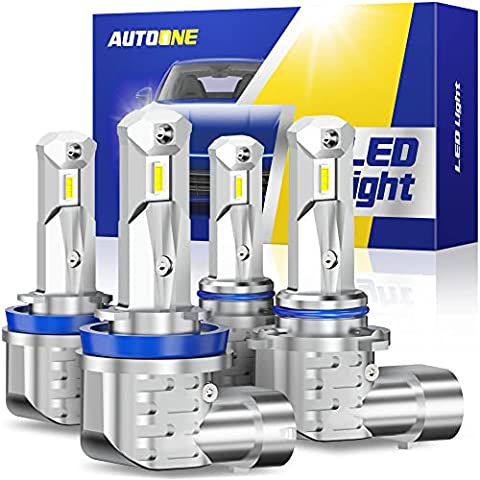LED Color Chart: Temperature Differences Explained
We keep getting a lot of questions on what is the difference between 5000k vs 6000k LEDs is, that’s why we decided to explain the key aspects that will help our readers understand the color temperature basics. Today. LED headlight upgrades are especially popular, both as replacements for headlight bulbs and as replacements for the bulbs used in the vehicle interior and exterior. As a rule, people do not replace the whole bunch of bulbs inside their vehicles at once.
Products are available — click below to view them!
SEE DETAILS ON EBAY
When LED bulbs are ordered in portions, some of them differ in color from the previous ones, which may look wrong as a result. The same happens when people select different color outputs for the low beams and fog lights that do not match when installed on the vehicle. Different kinds of automotive bulbs may differ in terms of color temperatures. That’s why, to keep as close to the topic as we can, we will discuss only those, that are normally used for the LEDs.
The First Vehicle with All-LED Tail Lights
Here is an interesting fact about the first usage of LED bulbs in automotive lighting. The first vehicle that featured tail lights where every bulb was LED was a concept car, Land Rover LCV 2/3. LCV stands for the ‘Light Concept Vehicle’. It was designed when the company was seriously investigating the option of a more lightweight vehicle that featured innovative specifications along with a smaller body and recognizable Land Rover design. It’s fair to say, that the first series of LCV prototypes were based on the LR Defender 90.
Even though this vehicle looks somewhat retro, it is very technologically advanced and more aerodynamic, than the Defender 90. The whole lighting system of the LCV project was supposed to be LED. Yet, because of the budget restrictions, the production investigations had to be cut. The rear tail light system was completely LED. Making the reverse light was a real challenge since white LEDs were not available in the early 1990s. The Blue LED technology had just arrived and was extremely expensive. The theory of the engineers was to use a combination of Red, Green, and Blue LEDs (RGB) to get white LED color.
The experiment appeared to be too expensive and did not meet the budget, so using LEDs for the other car lighting was impossible. That’s why the concept vehicle was equipped with standard tungsten filament bulbs for headlights and interior lighting. Land Rover has registered the concept vehicle to drive on public roads. That’s why the LCV became the first road-registered vehicle with full LED tail lights.
What color of LEDs is brighter?
So, you have decided to replace the bulbs with LEDs and you are wondering, what color to get. It’s crucial that you understand, that the color differences are about the style, but not that much about the brightness. It is the matter of the human eye to perceive white light as brighter, compared to yellowish-white. So, our eyes will consider 6000K LEDs to be brighter, compared to the 5500K, which is a natural white, and 5000K, which is warm white. The truth is, that the 5000K LED bulbs are as bright as 6000K LED, so selecting LEDs with one of these color temperatures is a matter of taste.
5000K vs 6000K LED: Comparison
Both 5000K and 6000K are very popular among those, who wish to upgrade the stock light bulbs to something brighter or more advanced. Even though these 2 colors may look very similar, it is a good idea to compare 5000K and 6000K to understand specs of each, differences and possible weaknesses that may influence your decision.
| NAME | 5000K LEDs | 6000 K LEDs |
|---|---|---|
| Color explanation | Day white | Cool white |
| Comparable light | Mid day | Overcast |
| Undertone | Neutral | Cool |
| Appearance | Look neutral | Look brighter |
| Automotive application | Interior/exterior | Interior/exterior |
| Aesthetic aspect | Look neutral | Look aftermarket |
| Product examples | HID xenon bulbs | 1st-gen LED bulbs |
| Price | CHECK PRICE | CHECK PRICE |
LED Color Chart: LED Temperature Understanding
If you wish to fully understand, how the temperature in Kelvin (K) influences the light output, it is a good idea to consider the color chart (also known as the Planckian locus graph) below. If you wish to better understand the way it relates to automotive lighting, look at the curve in the middle of the colored part of the graph. It shows all color temperatures that are normally used on vehicles (turn signals, reverse lights, stop signals, etc.).
The color choices between 3000K and 6000K are normally used by the manufacturers of LED bulbs that are installed into headlights, and fog lights and are used as parking lights.

What is the easiest way to remember the LED color chart?
As long as you have already paid attention to the LED color temperature chart, it may seem quite difficult to remember every detail of the graph. If you are looking for a quick tip that will help you remember the scheme, that’s how we do it. The lower the temperature in K, the closer the color is to yellow.
The higher is LED temperature, the more it goes blue and even purple. Speaking of the differences between 6000K LEDs and 5000K ones, think as we’ve just told you. 5000K is less than 6000K, so 5000K is natural white, which makes this color close to light yellow, while 6000K is a higher temperature, which makes look somewhat blueish (cool white).
The most common LED colors explained
| Color Temperature | Color | Color Details | Explanation |
|---|---|---|---|
| 2700K | Yellowish light with tint of orange | This is average temperature of regular halogen or incandescent bulbs, used by many carmakers as OE light bulbs. | The 2700K bulbs are less white, than the 3000K, and even have that tint of yellowish orange. Many car owners who decide to switch to LEDs upgrade this color to something whiter. |
| 3000K | Yellow | This is a typical yellow color of bulbs. LEDs in this color are commonly used in fog lights. | Yellow bulbs may be used in fog lights, if they have to look different from the headlight color. Yellow lights are deemed to be more visible to the other drivers in darkness, than white. |
| 3600K | Very light yellow | This is a bright light yellowish color of bulbs. | These light yellow bulbs may appear yellow. They provide descent on-road visibility at night, yet they may appear somewhat old-fashioned. This is the main reason why the car owners decide to replace them. |
| 4300K | Yellowish white | This is a typical color of factory HID bulbs. | This color is emitted by the majority of average OE HID bulbs. This is a white light with yellowish tint. It does not have that cool shade and does not look blueish. |
| 5000K | Natural white | This light color can be compared to the sunlight at noon. | Natural white LED color looks neutral to warm, and does not have that shade of blue. This light appears the brightest to the human eye, as it does not contain that blue undertone. |
| 5500K | Pure white | This color is 100% neutral and does not contain yellow or blue tint. | This is the purest white that looks free of any kind of shade. It has got neither yellow nor blue shade, and is the neutral light color. 5500K light blends well with other colors and easily matches both cool and warm colors. |
| 6000K | Cool white | This color falls between white and blue on the graph, creating cool white light. | Cool white LEDs provide good on-road visibility, while that blueish shade provides that exotic aftermarket looks. There is slight difference between 5000K, 5500K and 6000K LEDs. It gets more noticeable when these lights are compared next to each other. |
Is it possible to match new LEDs to the existing 5000K/6000K bulbs?
The quick answer is no. The thing is, that different brands use different materials to produce LED bulbs they offer, so 6000K bulbs by one brand most likely will differ from the other bulbs marketed as 6000K by the other brands.
Note, that some brands that offer cheaper LED on eBay or Amazon and do not note, that their products are street-legal or DOT-approved, may offer more purple/darker blue bulbs marked as 6000K. If you get such bulbs for your vehicle, you may get a ticket from a police officer, as blue lighting on the front fascia is not allowed in the U.S.
Which LEDs are better, fan or fanless?
It’s hard to say, which kind of LEDs will work better for the specific vehicle application. Today, fanless LEDs are recommended by many mechanics, as they employ a passive cooling system and feature a less complicated construction. It is fair to say, that the simpler construction is, the longer it will last, as there will be fewer components that may get damaged due to vibration. See the comparison of fan vs fanless LEDs below.
| # | FAN | FANLESS |
|---|---|---|
| 1 | Quick heat elimination | Some filaments with fans are too large |
| 2 | Slim fanless LEDs don’t require a lot of place | Fanless LED bulbs with braided heat sinks require checking the heat sinks condition from time to time |
| 3 | Do not require extra space | Noiseless operation |
| 4 | Do not come with external cooling units | Longer lifespan,compared to fan LEDs |
| 5 | Fan sometimes creates noise | Slim filament in quality LEDs |
| 6 | If the headlights are not sealed properly, fans may gather dust | Thermal resistance to drops |
| 7 | Fan may consume additional power | Fanless leds do not require extra maintenance |
Source of LED comparison chart: Hikari-LED.com
 Steven is a certified mechanic and technical writer at Halo Headlights. Steven is excited about fast cars, loud music, and car mods. On yearly basis, he visits SEMA, as well as other car shows.
Steven is a certified mechanic and technical writer at Halo Headlights. Steven is excited about fast cars, loud music, and car mods. On yearly basis, he visits SEMA, as well as other car shows.
He has installed thousands of HID and LED kits and done hundreds of custom headlight retrofit projects. Besides, he is an editor and author of multiple car-related articles on Wikipedia. Here is one of them: Automotive Lighting. Now, he is ready to share his experience with Halo-Headlights.com readers.
YOU MAY ALSO LIKE
 Chameleon Headlight Tint. This is one of the cheapest headlight and tail light mods to consider if you are looking for that impressive show car look. You can do the installation by yourself in under 1 hour and enjoy that custom effect.
Chameleon Headlight Tint. This is one of the cheapest headlight and tail light mods to consider if you are looking for that impressive show car look. You can do the installation by yourself in under 1 hour and enjoy that custom effect.
You can also apply this color-changing film to the taillights, fogs, and certain other accessory lighting in your vehicle. Trust us, you will love this simple mod if you pick a quality product.










